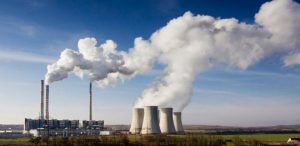Trump can’t revive coal – and neither can Brian Jean or Jason Kenney

With his image projected upon a huge screen, U.S. President Donald Trump speaks at the Conservative Political Action Conference, or CPAC, in Oxon Hill, Maryland, U.S., February 24, 2017. REUTERS/Kevin Lamarque
American experience with coal illustrates that carbon reduction, energy competitiveness go hand in hand
Brian Jean probably thought Donald Trump was a gift from Heaven back in Nov. Trump promised on the campaign trail to abandon the Democratic “war on coal” and erase the regulatory burden on US oil and gas producers. The Wildrose leader immediately hitched his party’s wagon to Trump and declared that Alberta could not get too far in front of its biggest customer – and competitor. Unfortunately for Jean, Trump the President has turned out to be a very different political animal than Trump the candidate.
I asked Wildrose energy critic Drew Barnes for an interview and the Medicine Hat MLA emailed me a statement outlining his party’s approach to energy and climate policies.
“We believe there is a consensus on the importance to reduce global emissions and Alberta has a role to play, but technological upgrades and efficiency incentives need to be enhanced without carbon taxes or other policies that put Albertans and our industries at an obvious disadvantage,” Barnes wrote.
“Wildrose believes no policy in emissions should act out of step with the US and other Canadian jurisdictions.”
Barnes probably wishes he could amend that statement after yesterday’s news story from the Washington Post that Trump is mulling a carbon tax as part of a compromise to thrash out a Congressional deal on tax reform. The Republican president promised to slash taxes for the middle class and businesses, now he has to find a way to pay for those pledges.
Dear Readers. Please take a minute to answer this simple, 10-question readership survey.
He is also still considering a border adjustment tax, which could have disastrous effects on the Alberta oil and gas sector.
It appears Jean believed Trump’s stump speeches as much as Trump did. Two and a half months into his administration and Trump is struggling with the realities of policy making. His first major initiative, scrapping Obamacare, was a disaster. And consensus around comprehensive tax reform is proving elusive.
Trump is also discovering the limits of the American government’s authority.
He promised to end the “war on coal,” revive the coal industry, and put laid off coal miners back to work. One of this first executive orders ended President Barack Obama’s Clean Power Plan – still hung up in law suits launched by Republican states – that would have whittled away at coal’s marketshare until it was virtually gone by 2030.
But, something funny happened on the way to the coal wars.
 Three things, actually. One, cheap fracked natural gas began displacing coal for power generation in a big way around 2008. Two, utilities could see the writing on the wall; pestered by law suits from environmental groups like the Sierra Club, they shuttered or committed to shutter 200 coal plants out of the 523 in the national fleet, many of which were at the end of their economic lives anyway. Three, the cost curves of renewables continued to drop, which convinced utilities they were the long-term future of the industry.
Three things, actually. One, cheap fracked natural gas began displacing coal for power generation in a big way around 2008. Two, utilities could see the writing on the wall; pestered by law suits from environmental groups like the Sierra Club, they shuttered or committed to shutter 200 coal plants out of the 523 in the national fleet, many of which were at the end of their economic lives anyway. Three, the cost curves of renewables continued to drop, which convinced utilities they were the long-term future of the industry.
Coal power plants generated around 56 percent of American electricity in the late 1980s and by 2000 still accounted for half of power generation. By the first quarter of 2016, coal accounted for only 32 percent, surpassed by natural gas for the first time.
“The Trump administration can end the ‘war on coal’ but it cannot halt the march of time and fatigue which is gradually culling the coal fleet,” says respected Reuters energy analyst John Kemp.
 Reuters recently surveyed 32 utilities in the 26 states that sued over the Clean Power Plan. Most said they will not change their multi-billion dollar plans to shift away from coal.
Reuters recently surveyed 32 utilities in the 26 states that sued over the Clean Power Plan. Most said they will not change their multi-billion dollar plans to shift away from coal.
“Utility planning typically takes place over much longer periods than presidential terms of office,” Berkshire Hathaway Inc-owned Pacificorp spokesman Tom Gauntt said.
Which brings us back to Alberta and its conservative parties, which may or may not be united into one party in the near future.
Premier Rachel Notley will never admit it publicly, but her government and the Trudeau Liberals in Ottawa have been purposefully following in Obama’s footsteps since they were elected.
After launching the Climate Leadership Plan in late 2015, Notley spent a year in lockstep with the Obama Administration. With the election of Trump, and with the Republicans controlling Congress, the NDP appeared to be out of step with the new American energy and climate direction.
Now, momentum seems once more to be shifting in her direction.
The Climate Leadership Plan committed to phase out coal power generation: two-thirds would be replaced by renewables, one-third by natural gas. Alberta’s goal would be 30 percent renewable energy by 2030.
Not unlike the United States.
Oh, the proportions will be different. The American power generation system is much larger and more reliant upon coal. Wind has gained only a 5 per cent marketshare and solar 1 per cent, but the EIA forecasts that renewables will likely catch coal’s marketshare before 2030, largely because a new American power generation model has evolved that will exacerbate coal’s decline: natural gas + wind + solar + battery storage + smart grid.
This is essentially the new Alberta power generation model, probably with less emphasis on solar for the foreseeable future.
Which puts Alberta squarely “in step” with the United States.
Barnes is wrong when he writes “the U.S. [is] turning away from carbon reductions and towards energy competitiveness…”
Trump is reconsidering withdrawing from the Paris climate accord after being lobbied by Big Oil CEOs. He’s considering a carbon tax. American utilities continue to close coal power plants.
The President is discovering what many in the energy industry already know: carbon reduction and energy competitiveness go hand in hand. They are complementary, not competitive. The Canadian Energy Research Institute came to the same conclusion in its recent study of new GHG emission-reducing technology for the Alberta oil sands.
When Barnes writes that “Wildrose would scrap the Climate Action Plan,” he is playing with fire. The Trump Administration illustrates nothing if not that campaign rhetoric has little to do with the realities of governing.
Trump can’t revive coal because the long-term economic and technological trends in the industry favour cleaner forms of power generation.
There is a lesson here for Wildrose – and perhaps the PC party if Kenney is still leading it in 2019. Jean and Kenney need energy and climate policies more compatible with the long-term trends bedevilling Trump.
A platform focused on scrapping the Climate Action Plan would be going backward, not forward.










Mark:
There should be no real issue with coal, and the industry need not be lumbered with clean power plans and numerous other regulations. But it should remain a choice for those businesses who calculate burning or mining coal is economical.
Natural gas or other green alternatives displace coal that is because it makes good sense for their business. Governments it has been said are poor prognosticators and selectors of the next big thing. What made Obama and his acolytes any better than others?
Trump has made it possible again for business to make their own choices and that is how it should be.
As for Alberta and its coal plants, I believe Albertans will come to regret their decisions, just as Ontarians regret the price paid for the closure or their plants and the exorbitant rise in electricity prices.
All the while China and India are burning scads of coal. And I do not blame them as they rush to pull their people from the firm grip of poverty. The world needs choices that make economic sense. Climate change may be a useful cudgel or incentive for advanced economies, but an impoverished Indian could never really see the point.
Perhaps wind and solar will be the best thing since sliced bread if we can make it work economically before Ontarians and Albertans are sent to the poor house.
Your writings over the past couple of months seem more strident. I don’t understand the reasons for your mission on the climate change discussion whether it is to wave that flag or move to wind and solar for sake of just not burning fossil fuels.
I would prefer to see a little more balance because sustainability should also mean economically viable.
Keith Harrison Why is Brian Jean changing his mind on coal usage? He and Jason Kenney were in the CPC with Jim Prentice,who wanted to get rid of coal usage for power generation. Brian Jean wanted to get rid of coal usage as a power source too. Now he doesn’t. Interesting. Alberta pays more for power because the Alberta PCs implemented electricity deregulation. This has cost Albertans over $30 billion for that mess.
An excellent and well thought out article. My first response is that the electricity generation market continues to evolve so quickly that it’s hard for us to accurately say where things are going.
A couple years ago the news was rife with stories about the coming end of large scale utilities and the impending arrival of micro grids. I always had trouble reconciling this with the density of power consumption in urban areas.
It seems to me that what’s really needed is a large scale sensitivity analysis of North America’s electricity system. Key imputs to play with would be demand, carbon price, fuel prices, interest rates and costs of new renewables and battery storage.
The next disruptions I think about are carbon pricing (especially if North Americans start to understand the existential threat of climate change). Carbon pricing could simultaneously hurt natural gas selection as a fuel and drive more power consumption for electricity for electric vehicles and for thermal.
The other thing I think about is natural gas prices. If the price were to drift back up to 6-8 dollars per MMbtu, things would change greatly.
But these are only the things I think about. What about the unknown unknows? It needs a subject matter expert and a modeler to get married and express their love by modelling every scenario that’s out there!
Finally, as an Ontarian I can’t help but comment about what Mark had to say about the Ontario market. Those who follow the situation closely know that the largest problem we wave right now is overcapacity. Demand dropped off after the 2008 recession and in defiance of the forecasts, remained flat. This is really noticeable when we have a low demand month and has become less of a problem since a nuclear reactor has been taken off line for (an expensive) refurbishment. Sure, wind and solar legacy costs are an important adder to our price, but the monthly IESO reports clearly show two things: i) low average hourly prices drive a huge monthly reconciliation payments to generators (Global Adjustment) and ii) the largest proportion of Global Adjustment payments are made for nuclear power. Finally I would note that the last auction for wind power came in at about 2 cents per kWh below the current wholesale power price. So at today’s cost, I fail to see how wind power will put anyone in the poor house.